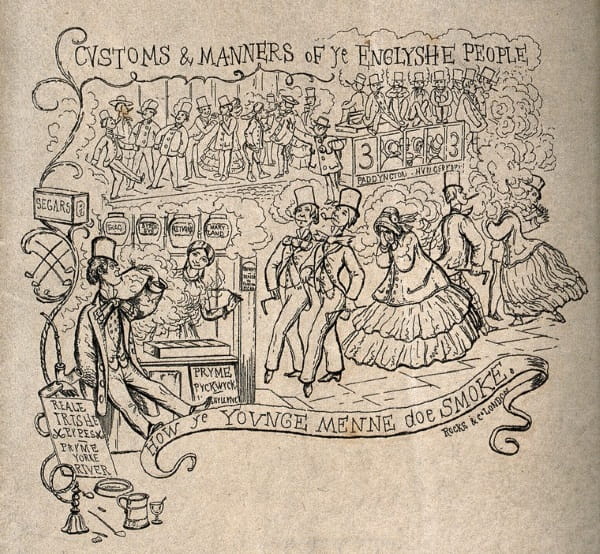#NoTobacco: Some historic perspectives on the use of tobacco
31 May 2019
Saffron Mackay
Above: “Englishmen smoking in a city street, thereby causing a nuisance to women. Etching.” Rock Brothers & Payne. [between 1850 and 1859?]. Image from the Wellcome Collection. Free to use with attribution CC BY.
The 31st May 2019 marks the 32nd World No Tobacco Day (WNTD). For 24 hours, a complete abstinence from tobacco products will be encouraged by the World Health Organisation, who established World No Tobacco Day in an attempt to draw global attention to the harmful impact of the proliferation of tobacco smoking. The focus in 2019 will be upon the effect tobacco has on the lungs.
According to statistics published by the World Health Organisation, tobacco still claims the lives of more than 7 million people each year, with 890,000 of these deaths being the result of non-smokers being exposed to second-hand smoke.
During this celebration of tobacco abstinence it might be fitting for us to explore the history of the use of tobacco and attitudes towards its consumption, using the RCS Library collections.
Above: “A tobacco plant (Nicotiana tabacum), its flowers and seeds, bordered by six scenes illustrating its use by man. Coloured lithograph, c. 1840.” Image from the Wellcome Collection. Free to use with attribution CC BY.
The use of tobacco originated in the Americas, where natives chewed and smoked the leaves. During the 16th century AD, after the arrival of Europeans in the Americas, popular consumption of tobacco quickly spread.
In 2016, 21,500 tracts and pamphlets held at the RCS Library were digitised and made readily available online as part of the UK Medical Heritage Library, with some of these focusing on the subject of tobacco.
Unsurprisingly, some authors of the pamphlets go down the more expected route in highlighting the benefits of tobacco. In Snuff-taking: Its utility in preventing bronchitis, consumption, etc. the author, John C. Murray, M.D., emphasises the benefits of snuff in a variety of medical treatments: the prevention of contagious diseases, colds and consumption headaches and “exciting respiration in the nearly drowned”.
It may come as a surprise to find that health professionals even back in 1857, were warning of the potentially dangerous effects of tobacco, considering the widespread popularity of tobacco during the 20th century and, as highlighted in findings by the World Health Organisation, even to this day.
One tract, A Dissertation on the Use and Abuse of Tobacco, which was published by Dr Adam Clarke in 1857, features some of the arguments against the consumption of tobacco and the various effects that it can have physically on the body, citing the work of individuals such as Dr Maynwaring in the Treatise on Scurvy. Dr Maynwaring is recorded to have written largely against the use of tobacco, citing that scurvy has abounded much more in nations since the introduction of tobacco. Dr Clarke also urged surgeons and anatomists to dissect the bodies of habitual smokers and snuff-takers to attempt to reveal the effects that the substance had on the body.
Another tract, The ‘Seven Deadly Sins’ of Civilization by George M Gould, M.D., which was published in 1907, condemns tobacco - along with coffee and tea, alcohol, sugar, venereal diseases, the modern house and eyestrain.
In the tract, Gould draws particular attention to the impact that smoking has on the body, citing a study of the effect of smoking on students, concluding that “those who did not use tobacco were twenty percent taller than the smokers, twenty-five percent heavier and possessed sixty-six per-cent more lung capacity”. Despite studies like this, Gould writes of the limited impact on the medical community, writing about the opinions promoted in the publication The Practitioner.
Despite condemnation as far back as 1857, it was only in 1948, when Richard Doll and Austin Bradford Hill published their findings linking smoking to lung cancer, that the medical community began to further investigate the harmful effects of tobacco. Since then stricter regulations have been implemented to try and deter smoking, including anti-tobacco adverts, tobacco taxes and bans to prevent smoking in public places.
For more information on World No Tobacco Day visit the World Health Organisation.
Saffron Mackay, Library and Archives Assistant




